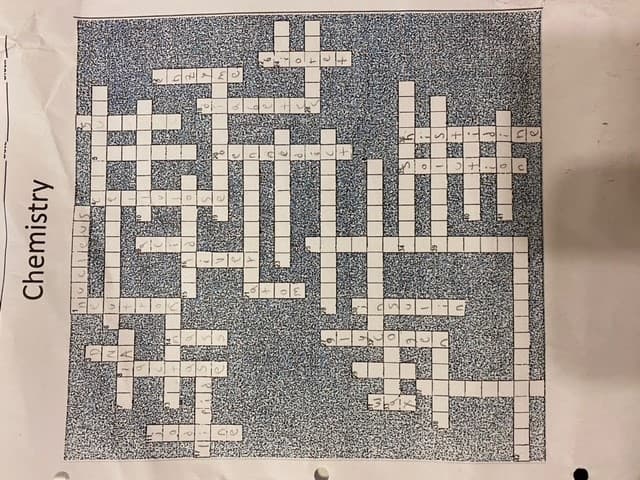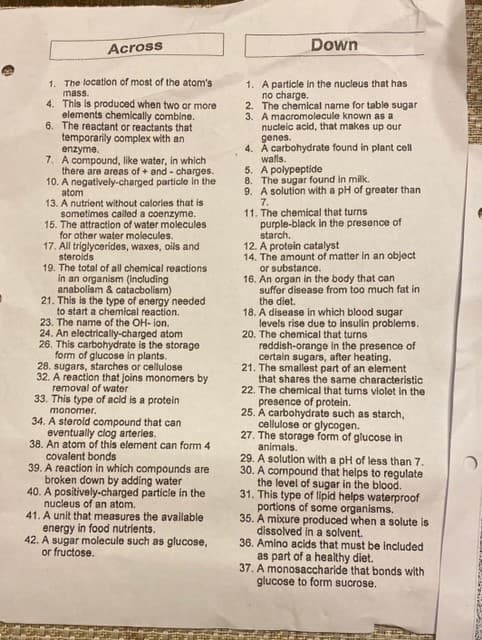Chemistry: Matter and Change
1st Edition
ISBN:9780078746376
Author:Dinah Zike, Laurel Dingrando, Nicholas Hainen, Cheryl Wistrom
Publisher:Dinah Zike, Laurel Dingrando, Nicholas Hainen, Cheryl Wistrom
Chapter23: The Chemistry Of Life
Section: Chapter Questions
Problem 5STP
Related questions
Question
100%

Transcribed Image Text:Chemistry

Transcribed Image Text:Across
Down
1. The location of most of the atom's
1. A particle in the nucleus that has
no charge.
2. The chemical name for table sugar
3. A macromolecule known as a
nucleic acid, that makes up our
genes.
4. Ā carbohydrate found in plant cell
walls.
5. A polypeptide
8. The sugar found in milk.
9. A solution with a pH of greater than
7.
11. The chemical that turns
purple-black in the presence of
starch.
12. A protein catalyst
14. The amount of matter in an object
or substance.
16. An organ in the body that can
suffer disease from too much fat in
the diet.
18. A disease in which blood sugar
levels rise due to insulin problems.
20. The chemical that turns
reddish-orange in the presence of
certain sugars, after heating.
21. The smallest part of an element
that shares the same characteristic
22. The chemical that turns violet in the
presence of protein.
25. A carbohydrate such as starch,
cellulose or glycogen.
27. The storage form of glucose in
animals.
29. A solution with a pH of less than 7.
30. A compound that helps to regulate
the level of sugar in the blood.
31. This type of lipid helps waterproof
portions of some organisms.
35. A mixure produced when a solute is
dissolved in a solvent.
36. Amino acids that must be included
mass.
4. This is produced when two or more
elements chemically combine.
6. The reactant or reactants that
temporarily complex with an
enzyme.
7. A compound, like water, in which
there are areas of + and - charges.
10. A negatively-charged particle in the
atom
13. A nutrient without calories that is
sometimes called a coenzyme.
15. The attraction of water molecules
for other water molecules.
17. All triglycerides, waxes, oils and
steroids
19. The total of all chemical reactions
in an organism (including
anabolism & catacbolism)
21. This is the type of energy needed
to start a chemical reaction.
23. The name of the OH- lon.
24. An electrically-charged atom
26. This carbohydrate is the storage
form of glucose in plants.
28. sugars, starches or cellulose
32. A reaction that Joins monomers by
removal of water
33. This type of acid is a protein
monomer.
34. A sterold compound that can
eventually clog arterles.
38. An atom of this element can form 4
covalent bonds
39. A reaction in which compounds are
broken down by adding water
40. A positively-charged particle in the
nucleus of an atom.
41. A unit that measures the available
energy in food nutrients.
42. A sugar molecule such as glucose,
or fructose.
as part of a healthy diet.
37. A monosaccharide that bonds with
glucose to form sucrose.
Expert Solution
This question has been solved!
Explore an expertly crafted, step-by-step solution for a thorough understanding of key concepts.
This is a popular solution!
Trending now
This is a popular solution!
Step by step
Solved in 2 steps with 1 images

Knowledge Booster
Learn more about
Need a deep-dive on the concept behind this application? Look no further. Learn more about this topic, chemistry and related others by exploring similar questions and additional content below.Recommended textbooks for you

Chemistry: Matter and Change
Chemistry
ISBN:
9780078746376
Author:
Dinah Zike, Laurel Dingrando, Nicholas Hainen, Cheryl Wistrom
Publisher:
Glencoe/McGraw-Hill School Pub Co

Chemistry: Matter and Change
Chemistry
ISBN:
9780078746376
Author:
Dinah Zike, Laurel Dingrando, Nicholas Hainen, Cheryl Wistrom
Publisher:
Glencoe/McGraw-Hill School Pub Co